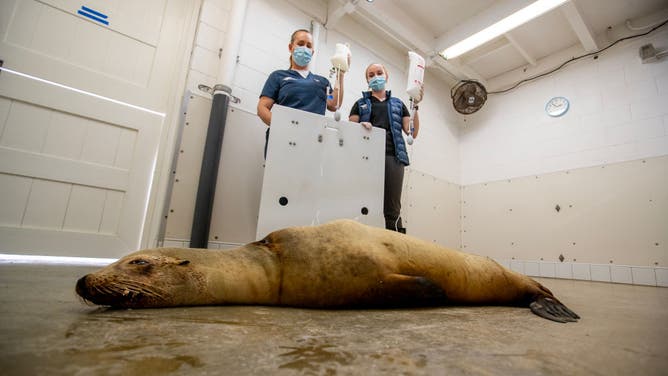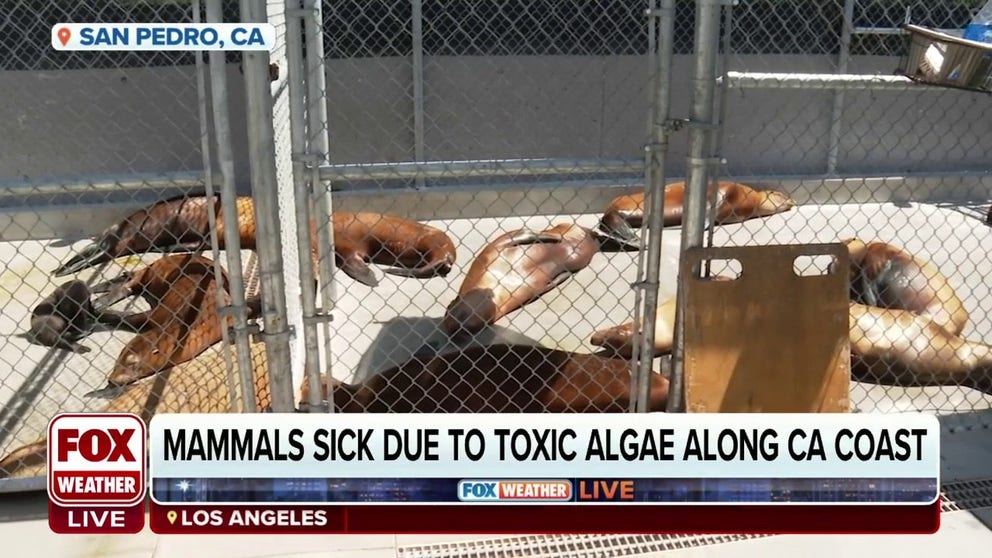Toxic algae bloom becoming deadly for sea lions, dolphins in Pacific Ocean
The toxic algae bloom event is overwhelming California sea mammal rescues. Dead sea lions and dolphins are washing up by the hundreds on the Pacific Coast.
Mammals getting sick due to toxic algae along California coast
Hundreds of dead sea lions and dolphins are washing up on California beaches and a toxic algae bloom is being blamed. FOX Weather's Max Gorden with more about what’s going on.
REDONDO BEACH, California – Sea mammal rescue organizations in Southern California are declaring an emergency due to deadly toxic algae bloom making marine mammals sick.
Hundreds of dead sea lions and dolphins are washing up from the Pacific Ocean, and sick sea lions are filling up every available space at marine mammal rescues.
Marine scientists say the toxic algae bloom produces the neurotoxin "domoic acid," which makes its way through the food chain to small fish and squid, which dolphins and sea lions eat.
When consumed, the neurotoxin can kill sea mammals or they wash on shore very sick with seizures.
Marine Mammal Care Center CEO John Warner said the toxic algae problem is twofold.
"In Los Angeles County, everyone knows it’s summertime, and many people are out on the beaches, which causes a real human safety issue," Warner said. "But it’s also very stressful on the animals, so the timing is not perfect at all. And we currently have so many animals showing up on the beaches that our hospital is full."

Dr. Alissa Deming, left, and veterinarian assistant Malena Berndt, give anti-seizure medicine to a California Sea Lion named Patsy in a recovery room at the Pacific Marine Mammal Center in Laguna Beach after it was found in Huntington Beach having seizures from toxic algae blooms Tuesday, June 20, 2023. (Allen J. Schaben / Los Angeles Times via Getty Images)
(Getty Images)
Unfortunately, the dolphins don’t usually make it after washing up, but marine biologists can care for sea lions by giving them an IV if they can get them to a care center. If they make it in time, sea lions can recover after a few days.
Scientists say that this bloom is a significant event, and it’s overwhelming some organizations that rescue sick marine mammals.
The Marine Mammal Care Center in San Pedro is building more pens because of the influx of sick sea lions.
KILLER WHALES SPOTTED SWIMMING OFF NANTUCKET IN ‘UNUSUAL’ SIGHT IN NEW ENGLAND WATERS
Toxic algae blooms regularly occur, but scientists say this latest bloom is caused by a seasonal upwelling of cold, nutrient-rich ocean water triggered by wind patterns.
Southern California Coastal Ocean Observing System Executive Director Dr. Clarissa Anderson said scientists don't know how bad the bloom is or where it originated.
"It appears to be an offshore event, not a nearshore event," Anderson said. "In my career, this is about the worst I’ve seen in terms of the impact on the marine mammal community in a small localized area in Central California to Southern California."
Anyone who sees a sick animal at the beach should not approach it and instead alert a lifeguard or local authorities.
